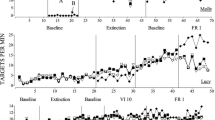Abstract
In the context of instructional demands, compliance and problem behavior can be considered concurrent operants. Of applied interest is increasing one response (i.e., compliance) while decreasing the other (i.e., problem behavior). Strategic arrangement of reinforcement can alter response allocation accordingly. Such schedules can also influence response persistence and generalization. A case study is used to illustrate the effects of stimulus—reinforcer relations in a concurrent-operants arrangement involving an adult with developmental disabilities and problem behavior. Results are discussed in the context of basic operant research findings in the areas of stimulus control and behavioral persistence.
Similar content being viewed by others
References
Dube, W. V., & McIlvane, W. J. (2001). Behavioral momentum in computer-presented discriminations in individuals with severe mental retardation. Journal of the Experimental Analysis of Behavior, 75, 15–23.
Dube, W. V., & McIlvane, W. J. (2002). Reinforcer rate and stimulus control in discrimination reversal training. The Psychological Record, 52, 405–416.
Fisher, W. W., Piazza, C. C., Bowman, L. G., Hagopian, L. H., Owens, J. C., & Slevin, I. (1992). A comparison of two approaches for identifying reinforcers for persons with severe and profound disabilities. Journal of Applied Behavior Analysis, 25, 491–498.
Horner, R. H., & Day, M. D. (1991). The effects of response efficiency on functionally equivalent competing behaviors. Journal of Applied Behavior Analysis, 24, 719–732.
Iwata, B. A., Dorsey, M. F., Slifer, K. J., Bauman, K. E., & Richman, G. S. (1994). Toward a functional analysis of self-injury. Journal of Applied Behavior Analysis, 27, 197–209. (Reprinted from Analysis and Intervention in Developmental Disabilities, 2, 3–20, 1982)
Kennedy, C. H. (1994). Manipulating antecedent conditions to alter the stimulus control of problem behavior. Journal of Applied Behavior Analysis, 27, 161–170.
Mace, F. C., Lalli, J. S., Shea, M. C., Lalli, E. P., West, B. J., Roberts, M., et al. (1990). The momentum of human behavior in a natural setting. Journal of the Experimental Analysis of Behavior, 54, 163–172.
Marcus, B. A., & Vollmer, T. R. (1996). Combining noncontingent reinforcement and differential reinforcement schedules as treatment for aberrant behavior. Journal of Applied Behavior Analysis, 29, 43–51.
McComas, J. J., & Mace, F. C. (2000). Functional analysis of challenging behavior. In E. S. Shapiro & T. Kratochwill (Eds.), Behavior assessment in schools: Theory, research, and clinical foundations (pp. 78–103). New York: Guilford.
McComas, J. J., Wacker, D. P., & Cooper, L. J. (1998). Increasing compliance with medical procedures: Application of the high-probability request sequence procedure with a toddler. Journal of Applied Behavior Analysis, 31, 287–290.
McComas, J. J., Wacker, D. P., Cooper, L. J., Peck, S., Golonka, Z., Millard, T., et al. (2000). Effects of the high-probability request procedure: Patterns of responding to low-probability requests. Journal of Developmental and Physical Disabilities, 12, 157–171.
McDowell, J. J. (1988). Matching theory in natural human environments. The Behavior Analyst, 11, 95–109.
McIlvane, W. J., & Dube, W. V. (2000). Behavioral momentum and multiple stimulus control topographies [Commentary]. Behavioral and Brain Sciences, 23, 109.
Nevin, J. A. (1992). An integrative model for the study of behavioral momentum. Journal of the Experimental Analysis of Behavior, 57, 301–316.
Nevin, J. A., & Grace, R. C. (2000). Behavioral momentum and the law of effect. Behavioral and Brain Sciences, 23, 73–130.
Nevin, J. A., Mandell, C., & Atak, J. R. (1983). The analysis of behavioral momentum. Journal of the Experimental Analysis of Behavior, 39, 49–59.
Nevin, J. A., Tota, M. E., Torquato, R. D., & Shull, R. L.(1990). Alternative reinforcement increases resistance to change: Pavlovian or operant contingencies? Journal of the Experimental Analysis of Behavior, 53, 359–379.
Peck, S. M., Wacker, D. P., Cooper, L. J., McComas, J. J., & Richman, D. (1996). Choice-making treatment of young children’s severe behavior problems. Journal of Applied Behavior Analysis, 29, 263–290.
Tota-Faucette, M. E. (1991). Alternative reinforcement and resistance to change. Unpublished doctoral dissertation, University of North Carolina at Greensboro.
Wacker, D. P., Berg, W. K., Harding, J. W., Barretto, A., Rankin, B., & Ganzer, J. (2005). Treatment effectiveness, stimulus generalization, and acceptability to parents of functional communication training. Educational Psychology, 25, 233–256.
Author information
Authors and Affiliations
Corresponding author
Rights and permissions
About this article
Cite this article
McComas, J.J. Response persistence: The effects of stimulus control on negatively reinforced problem behavior in a concurrent operant. BEHAV ANALYST 32, 301–307 (2009). https://doi.org/10.1007/BF03392193
Published:
Issue Date:
DOI: https://doi.org/10.1007/BF03392193




